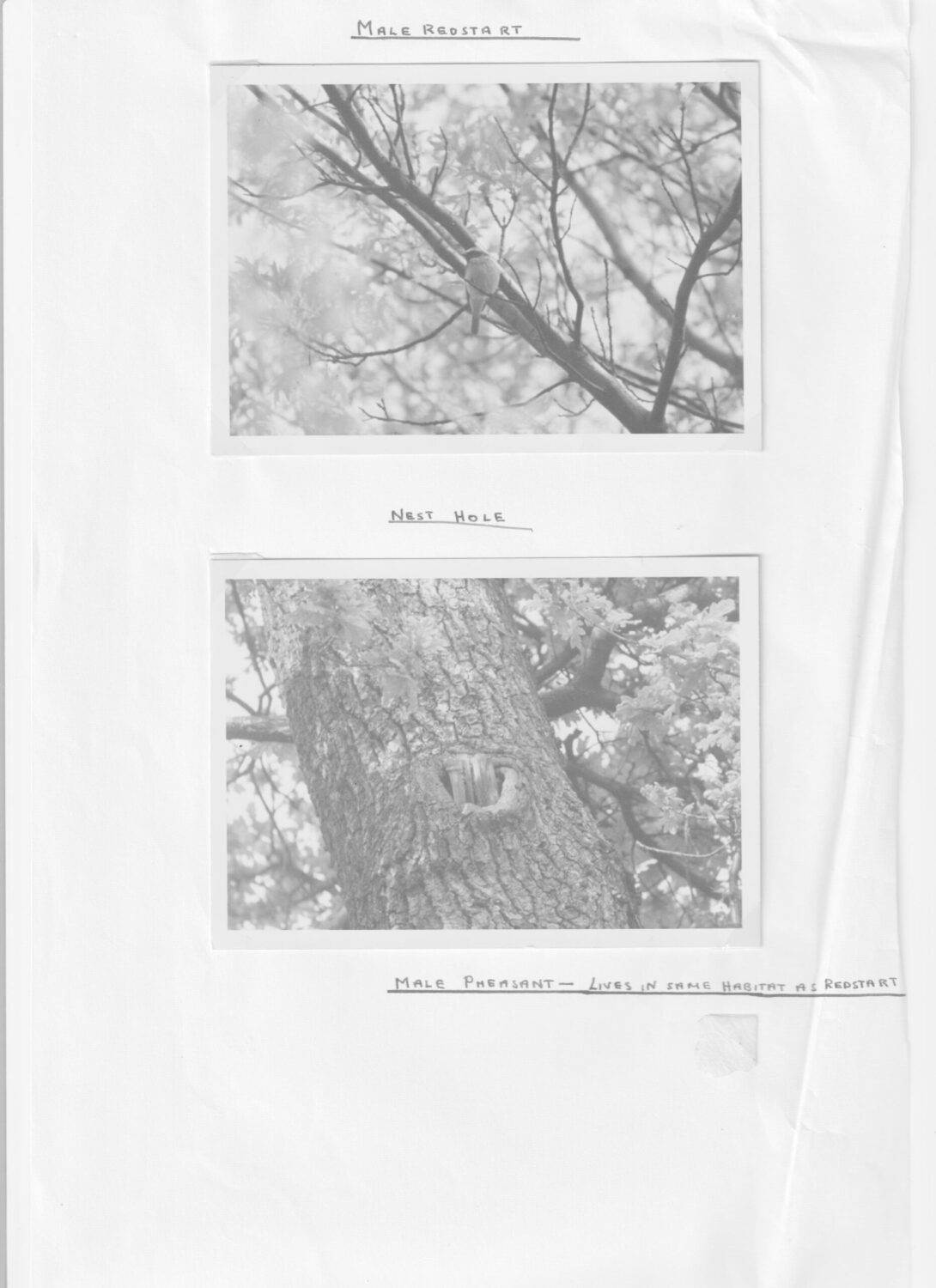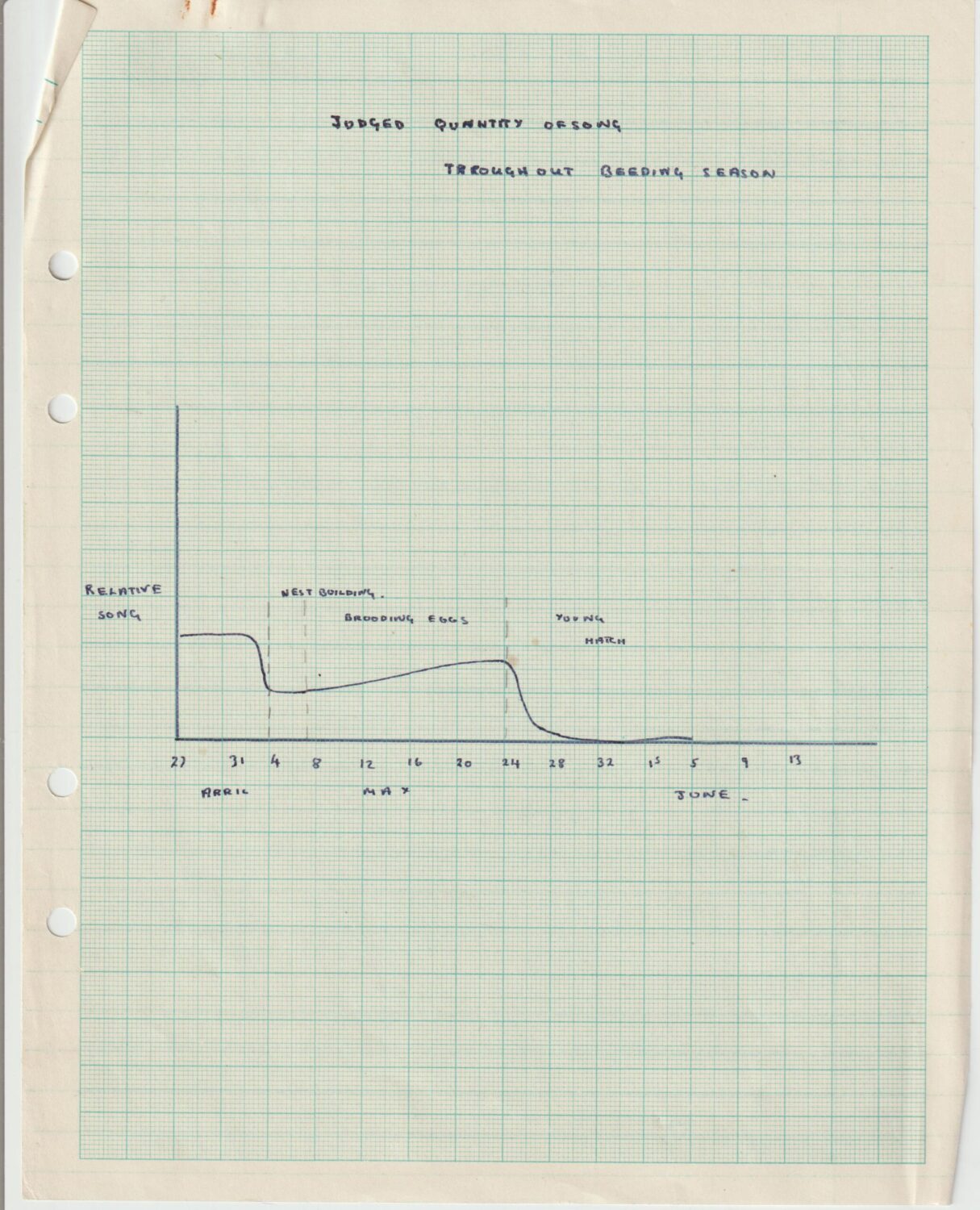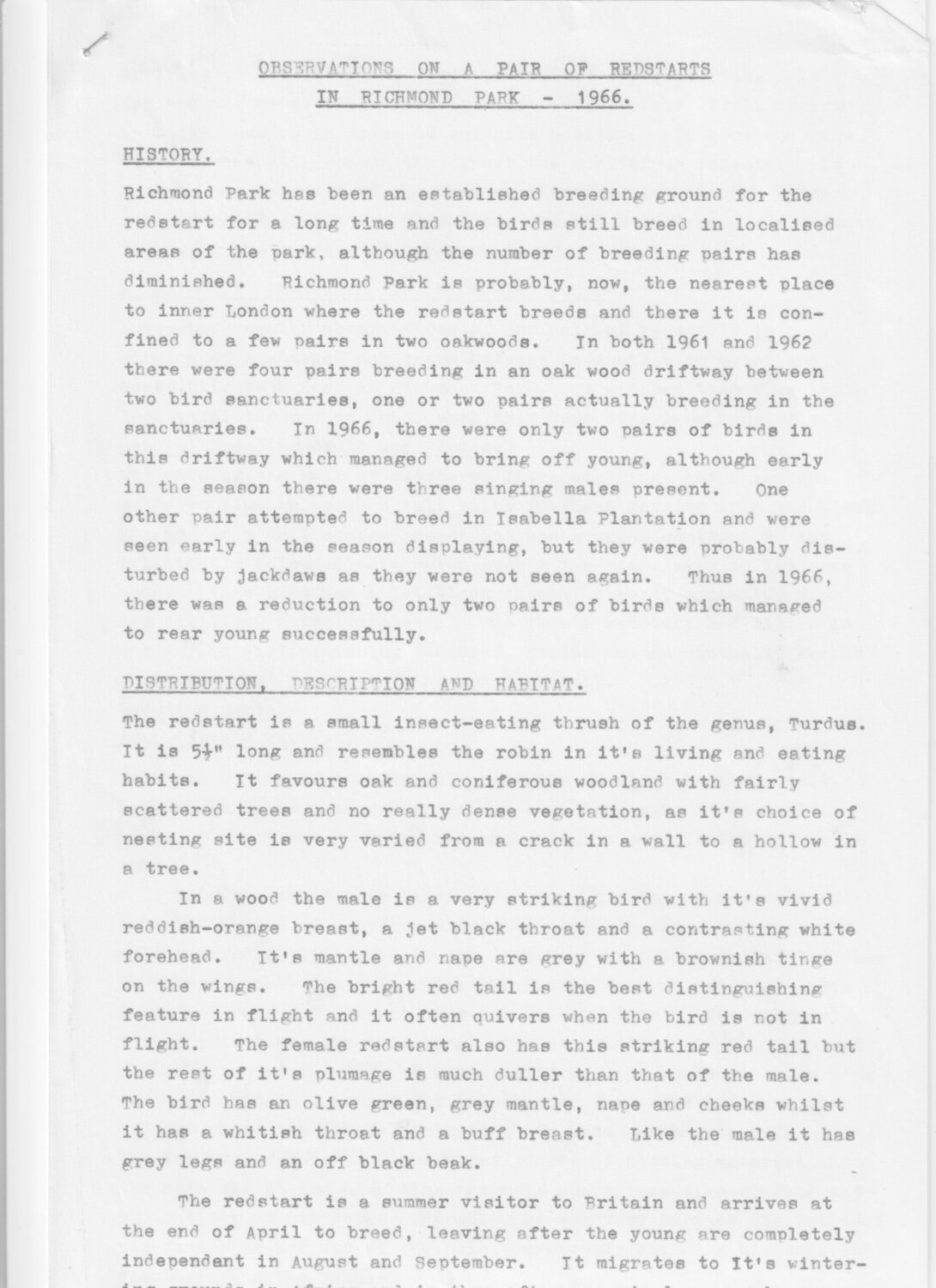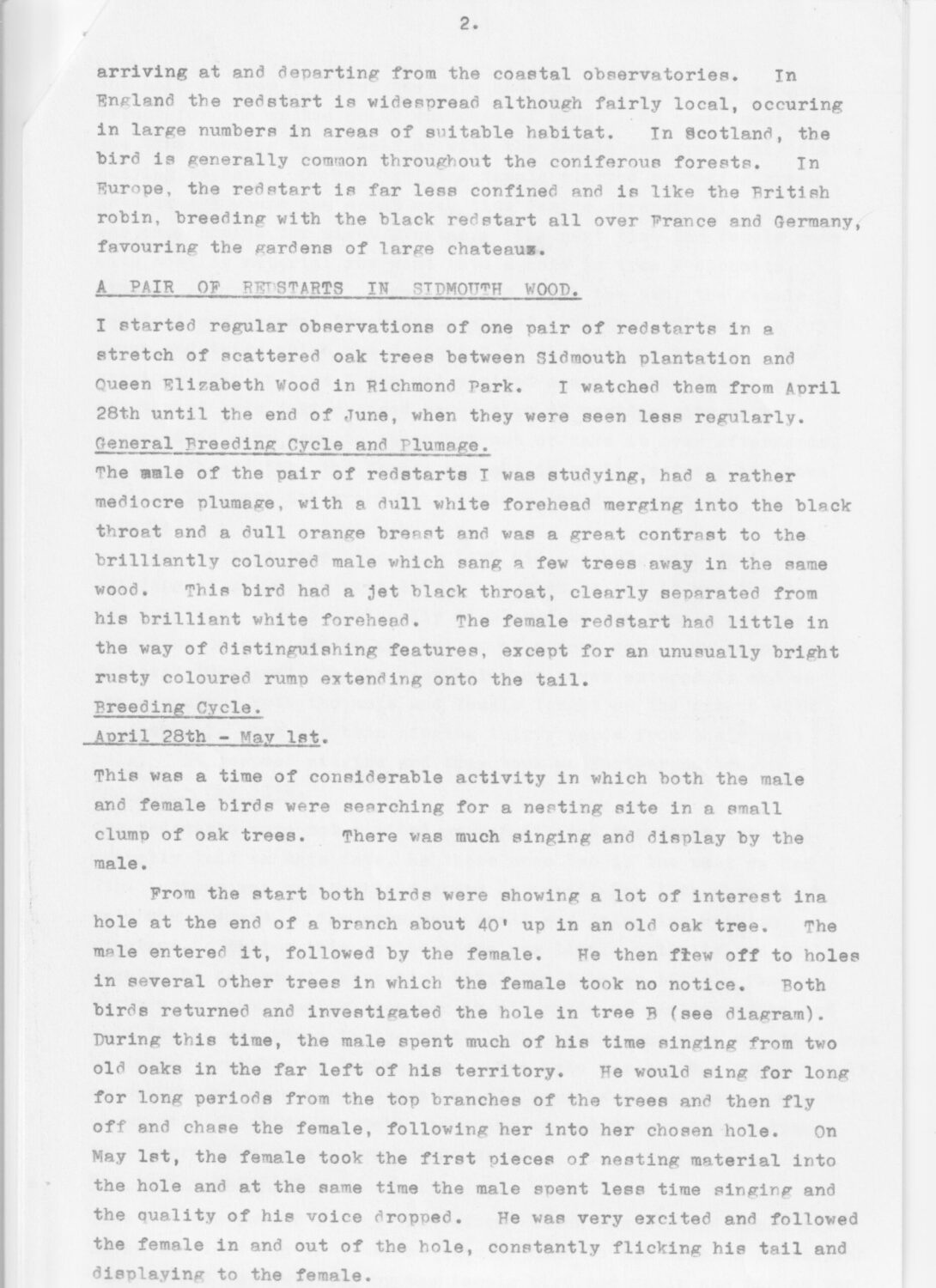It is May 25th in a small wood near Allendale in Northumberland and I am watching a female redstart taking nesting materials into a crack in a stunted ash tree: lichen picked off a branch, dangling strands of grass, a fine white feather. The male follows her everywhere she goes: into the yellow-flowered gorse, the top of the birch tree, the hawthorn blossom. I wonder, is he a besotted lover or a jealous male? Either way, he doesn’t help collect any nest materials – but here I go, putting human values onto a redstart. In redstart world, this is just how it is. And in my world, I am loving the fine colours, the vibrating tail, the intrigue and the inspiration for dreaming…it is just as it is.
But my story actually starts on the afternoon of April 11th. I took the 15-minute walk down from my house to the little wood pasture we know as Magic Land and there I first saw that red tail amongst the bare tree branches. My heart leapt – ‘He’s back!’ – and then I saw another, a female, and my whole body smiled. Truly this was magic land – in this world of so much fragmentation, they offered a sense of wellbeing and belonging. Flying thousands of miles across land and sea: the forest, the Sahara desert, the farmed lands of Europe to this little wood – the same wood they had nested last year.
Let me explain – our relationship goes back 54 years: Way back, when I was a schoolboy in London, I watched a pair of redstarts nesting in Richmond Park. I was a poor pupil in most things and struggled with exams. I was kicked out of the CCF, was rubbish at rugby … but I was completely hooked by wildlife: I collected skulls, bred moths in my bedroom, spent hours sitting in trees waiting for badgers – but most importantly I used to stop at the redstart’s nest on my cycle ride to school – for a short time, they became my companions and I kept a journal of their comings and goings. And then something extraordinary happened, I was momentarily lifted off the bottom rung at school by winning a prize for my bird study. It was one of my very few sprinklings of academic stardust and one of my first forays into storytelling.
During the lockdown attic clear-out, I found the project file of tatty, yellowing foolscap paper with its smudgy typing and fuzzy bird pictures and felt a warm glow – these wee creatures were offering a continuity and reassurance that bridged the years. Like my lingering in the woods, on my way to school, a significant part of lockdown for me has been about allowing myself to gaze into a seemingly empty, rush-filled field for hours on end. And wait as it reveals its hidden abundance: first one hare, then another and then a realisation that there are actually five in a circle in wordless conversation. The one lapwing, I first noticed becomes four – and where on earth were those two curlews when I arrived? The sound of a snipe thrumming overhead is joined by another. Orange-tip butterflies dance over the grass to the song of a trilling meadow pipit.
At first sitting like this, still in a field, was a bit of a struggle. There was a voice in the back of my head saying, ‘you should be doing something’. Then I heard the field whispering back, ‘you are’.
But back to the redstarts. After their initial appearance on April 11th, I saw them once again and then they disappeared. There was a sadness amongst the trees, my friends had gone. One evening, I was sitting under an oak, ever hopeful, when a sparrowhawk flashed through the wood trailing a screeching starling from its talons. Or at least that’s what I thought I saw, what I actually saw was a flurry of feathers – a dramatic blur . The sparrowhawk bit, is a story I pieced together a few seconds later.
The event was exciting but left me feeling even more despondent as I said to myself, that is where my redstart has gone, eaten by a sparrowhawk. For a moment I even noticed my inner ‘gamekeeper’ come out. I love sparrowhawks but not when they eat my redstarts. But all of that was storytelling too, I had no idea where the redstarts had gone. Us humans are compulsive storytellers, trying to make sense of a chaotic world by making connections between events.
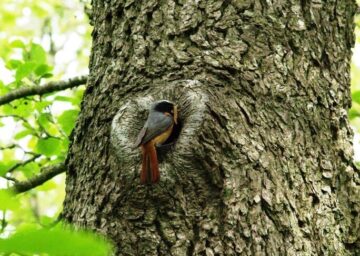
Then on April 28th, sitting on top of the tallest conifer tree was a singing male redstart. I was very happy but felt slightly foolish after having concocted all these ‘East-enders’ type scenarios as to the reasons for his disappearance. That morning I actually heard 5 redstarts singing from different perches on my mile walk… Now the redstart’s song, I have always dismissed as a nice jaunty rattle but a little underwhelming, saying to myself that their beauty is in their plumage and flickering tail. ‘Listen again,’ said my friend Geoff Sample, ‘to the bit after the rattle’.
And I did, remembering the words from ‘the empty field’ that this was my work. I hear the song quite differently now – its cadences and subtlety flow through me and I can sit for ages appreciating my little mate unashamedly singing his heart out from the top of the highest tree. A song that resonates over the fields and fences far beyond anything, I could have before imagined.
He sang day after day and I imagined that in some hidden hole in a tree, his missus was sitting on a clutch of eggs, though I was surprised I never saw even the briefest flicker of her red tail. I did occasionally wonder, was this the song of joy and celebration, I assumed? …I hoped it was.
Then on May 24th, I saw her for the first time, taking bits and pieces in to a hole, in the same tree as they nested in last year. The eggs must have hatched, she must be taking in food, Halleluiah! But how on earth had I not noticed this before? Then I realised that the male wasn’t helping and I was surprised. I looked more carefully, the ‘food’ started to look like grass and moss – She was making a nest. My story of the two previous weeks fell apart, he had not been singing for his invisible mate sitting on a nest. She had only just arrived – It was more likely a song of yearning.
The story-making began again where had she been? – had she deserted another mate? was this her second nesting attempt? had she just brushed the dust of Africa off her feathers? I have no idea except that they are probably all wrong and anyway what does it matter?
I am glad to say that they are now feeding a brood of little youngsters and I am out there most days watching my little companions and wishing them well.
And if that’s a story, it’s a true one!
About the author
Malcolm Green is a storyteller with a background in natural science and a particular interest in the way that stories can give voice to the ‘more than human’ world.
In particular, he enjoys creating performances that weave together two kinds of story: the mythological and the ecological. He is currently performing a show with his musician son, Joshua, called Gone Cuckoo. This reveals the story behind a BTO satellite-tagged English cuckoo, whilst also taking us on a journey of the human imagination.
Malcolm has done much storytelling work in education and has lectured in storytelling at Newcastle University for the past 18 years.
He is a co-founder of A Bit Crack North East Storytellers and chair of the Ndanifor UK Trust, a charity that supports an eco-village in Cameroon.
